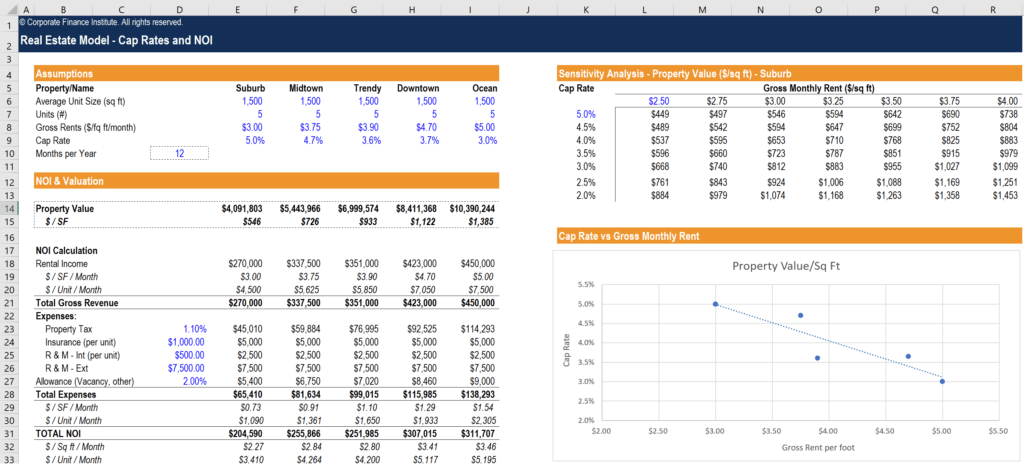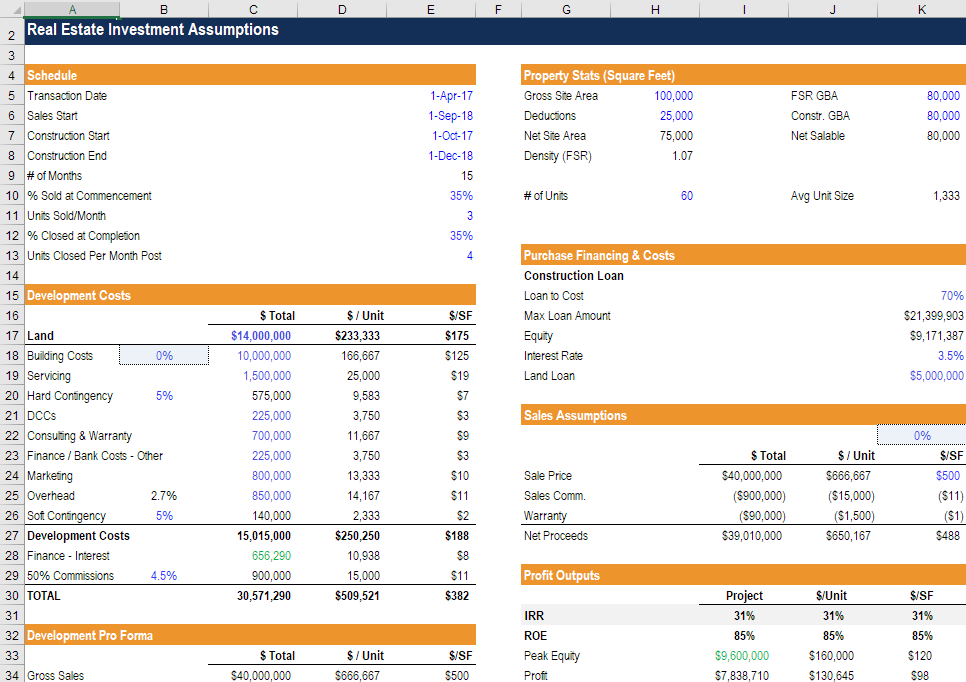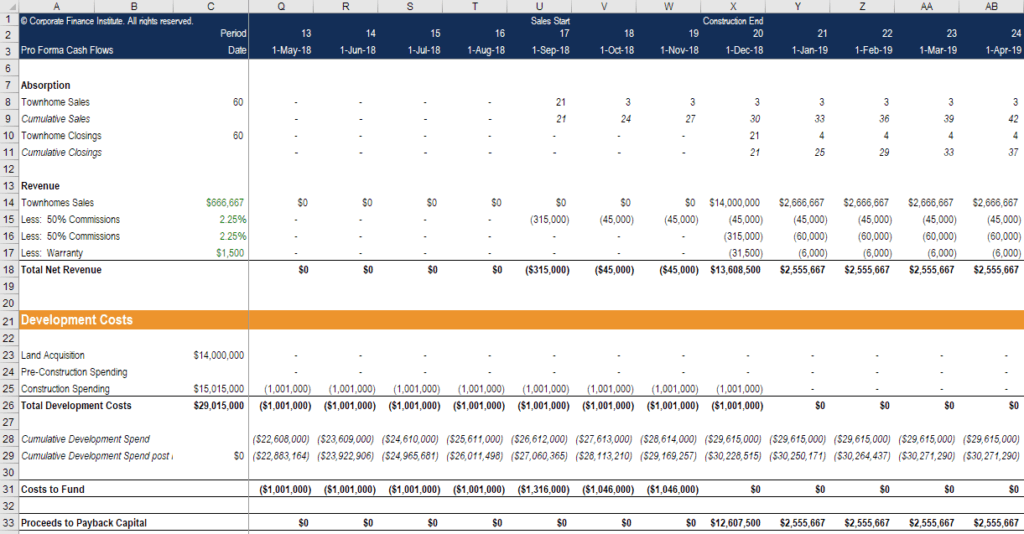
Foundations of Real Estate Financial Modeling
Overview of key concepts
The Foundations of Real Estate Financial Modeling
This guide will outline the foundations of real estate financial modeling and the key concepts you need to get started building your own models for development projects.
In order to get started, we will begin by defining some of the key terms you’ll need to know before building your model.

Real Estate Terms and Definitions
LTV – “loan to value” – the amount of debt financing a lender will provide as a percent of the market value (e.g., 80%)
LTC – “loan to cost” – the amount of debt financing a lender will provide as a percent of the cost of a development (e.g., 70%)
NOI – “net operating income” – gross rental revenue less operating expenses (property taxes, insurance, repairs & maintenance, capital expenditures, etc.)
Cap Rate – net operating income divided by the value of the property, expressed as a percentage (e.g., 4.5%)
Amortization period – the number of months/years the principal repayments of a loan are spread out over. The total length of time it will take you to pay off your mortgage (e.g., 30 years).
Structures and Joint Ventures (JVs)
Most developments are structured as a joint venture between General Partners (GPs) and Limited Partners (LPs).
Key points about GPs:
- Responsible for all management decisions
- Fiduciary duty to act for the benefit of the limited partners
- Fully liable for its actions
- May have guarantees as security on borrowing
Key points about LPs:
- Limited refers to “limited liability”
- Have priority on liquidation, ahead of the GPs
- Provide capital to fund the development project
- Have no control over the management of the fund/project
Assumptions Section of the Financial Model
As covered in CFI’s real estate financial modeling course, the key assumptions that will be input into the model include:
- Schedule
- Property Stats
- Development Costs
- Purchase and Sale
These are discussed in great detail in our actual course.
Development Cash Flow Model
To set the foundations of real estate financial modeling, it is important to cover the key sections that will be built based on project assumptions.
The key sections in the development model include:
- Absorption (timing and pace of sales)
- Revenue
- Commissions
- Warranty
- Land acquisition (capital cost)
- Pre-construction costs
- Construction costs
- Financing and interest expense
- Levered Free Cash Flow
Output and Pro Forma
Once the model is built, it’s important to create a one-page summary document or Pro Forma that can be shared with bankers, investors, partners, and anyone else who needs to analyze the deal.
This output pro forma should include the following information:
- Property stats
- Schedule – summary key dates
- Financing assumptions
- Sales assumptions ($ total / per unit / per SF)
- Budget ($ total / per unit / per SF)
- Returns (IRRs)
- Return on cost
- Return on sales
- Sensitivity analysis
Example of a Real Estate Financial Model
This is an example of the one-page output from our real estate financial modeling course. As you can see, it clearly displays all the information listed above and makes it easy for someone to evaluate the deal.
Here is an example of the actual inner workings of the model, where you can see absorption by month for the development project, which builds up to revenue and, ultimately, cash flow.
These foundations of real estate financial modeling are covered along with much more detail in our online course.
Cap Rate and Net Operating Income (NOI) Example
Net operating income, which is equal to gross rental revenue less operating expenses (property taxes, insurance, repairs & maintenance, capital expenditures), is the key profitability or cash flow measure used to evaluate real estate development transactions.
Cap rate, which is equal to net operating income divided by the value of the property, is expressed as a percentage and used to value real estate. The lower the cap rate, the more highly valued a piece of real estate is, and the higher the cap rate, the less valued the real estate is. Price and cap rate move in inverse directions to each other, just like a bond. Learn more in our financial math course.
Financial Modeling Course
The best way to learn is by doing, and CFI’s real estate financial modeling course gives you the step-by-step instruction you need to build financial models on your own. It comes with both a blank template and a completed version, so you can easily build a model on your own or just go straight to the completed version. The high-quality video instruction will guide you every step of the way as you work through a case study for a townhouse real estate development project.
Additional Resources
Thank you for reading CFI’s guide to Foundations of Real Estate Financial Modeling. To learn more about valuation, corporate finance, financial modeling, and more, we highly recommend these additional free CFI resources:
Analyst Certification FMVA® Program
Below is a break down of subject weightings in the FMVA® financial analyst program. As you can see there is a heavy focus on financial modeling, finance, Excel, business valuation, budgeting/forecasting, PowerPoint presentations, accounting and business strategy.
A well rounded financial analyst possesses all of the above skills!
Additional Questions & Answers
CFI is the global institution behind the financial modeling and valuation analyst FMVA® Designation. CFI is on a mission to enable anyone to be a great financial analyst and have a great career path. In order to help you advance your career, CFI has compiled many resources to assist you along the path.
In order to become a great financial analyst, here are some more questions and answers for you to discover:
- What is Financial Modeling?
- How Do You Build a DCF Model?
- What is Sensitivity Analysis?
- How Do You Value a Business?



